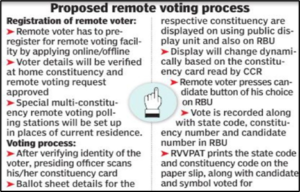ForumIAS announcing GS Foundation Program for UPSC CSE 2025-26 from 27th May. Click Here for more information.
Contents
Source: The post is based on the article “Election Commission says ready with remote EVM which will enable migrants to vote outside their States” published in The Hindu on 30th December 2022
What is the News?
The Election Commission of India has announced that it has developed a prototype for a Multi-Constituency Remote Electronic Voting Machine(RVM) which would enable remote voting by migrant voters.
What is Remote Voting?
Remote voting may take place in person somewhere other than an assigned polling station or at another time, or votes may be sent by post or cast by an appointed proxy.
Why do we need Remote voting?
Registered voters do not end up voting for a variety of reasons. One of the major contributors to this is domestic migration in the Indian context.
As per the 2011 census (the numbers will have risen since then), there were nearly 45.36 crore migrants in India (both intra and inter-state). It is approximately 37 percent of the country’s population. Migration can be driven by a variety of different reasons, from marriage to natural disasters to employment.
This means that there is a large chunk of the population that is denied its franchise due to exigencies of work or lack of resources to travel. This goes directly against the EC’s “No voter left behind” goal.
The idea behind Remote voting is to ensure these migrant voters participate in the electoral process.
What has the Election commission developed?
Source: TOI
The Election Commission has developed a Remote Electronic Voting Machine(RVM) to enable remote voting by migrant voters.
The RVMs are stand-alone, non-networked systems, effectively providing the voter the same experience as currently used EVMs.
They will be set up in remote locations outside the state under similar conditions as current polling booths.
The unique feature of RVMs is that a single Remote Ballot Unit (RBU) will be able to cater to multiple constituencies (as many as 72) by using a dynamic ballot display board instead of the usually printed paper ballot sheet on EVMs.
The Ballot Unit Overlay Display (BUOD) will show the requisite candidates based on the constituency number read on the voter’s Constituency card. A barcode scanning system will be used to read these cards.
What will be the voting process under RVM?
The voting process will be as follows: after verifying a voter’s identity, their constituency card will be read with a public display showing the constituency details and candidates. This will also be displayed privately, on the BUOD in the RVM’s RBU.
The voter will then vote, and each vote will be stored constituency-wise in the control unit of the voting machine.The VVPAT system is expected to work along the same lines with the new technology.
What are the challenges with remote voting?
Source: PIB






